
what is held, is here michele elliot

Foreword
In her exhibition what is held, is here, Michele Elliot, through quiet sensibility and careful attentiveness, weaves narratives of human experience. Her exploration of materiality and process make evident the labour of connections over time, traces of the hand into drawn, stitched, bound and printed stories.
Material is central to Michele’s art practice. We encounter bark, bedsheets, blossoms, cotton, dyes, gold, lemongrass, linen, silk, silver, smoke, wood and walnut are brought into conversation through making and the language of textiles. Elliot has for some years been drawn to work with that which is ‘at hand’, things gathered, gifted, and found. Garments, household linen, cloth fragments and personal objects form the ground on which memories are re/membered. Time collapses and expands; distance and proximity are found in equal measure. A fallen branch, an earthquake, bushfire, the death of a sibling become the meeting place.
Michele’s material language and use of intimate objects – clothing, hair, sheets - evokes a tenderness and wish for reparation. Thread is integral to this process, physically and conceptually. It becomes a narrative and a structural device, and stitching a form of drawing connecting across different spaces and times.
Michele’s art practice is informed by her work with community, in an approach that began in 2017 with an artist residency at Tender Funerals in Port Kembla. Here, she worked with families to support them in finding creative rituals, making wrapping cloths for mortuary care and facilitating the Sewing Circle, which still gathers today. These experiences continue into her artwork.
In her photographic series - the confidantes – with its genesis in her residency at Tender, Elliot brings forward memory, recollection and the object in stitched handkerchiefs that once belonged to her late father. The handkerchiefs were held and stored for some years until she commenced this durational stitching project. Elliot has drawn on her community and practice of social engagement in the confidantes with the inclusion of invited stories from twenty-two women whose fathers are remembered here.
This enfolding of people, of coming together within Elliot’s studio work and in her engagement with her community, is at the heart of her practice. It is where we meet, where we recognise each other and embrace our common ground. what is held, is here invites us into Elliot’s contemplation of frailty, loss, longing and materiality, walking with us into our shared and layered community. We thank Michele for presenting this evocative and thoughtful exhibition at Wollongong Art Gallery and encourage you to accept her generous invitation to attend to the stories it tells.
John Monteleone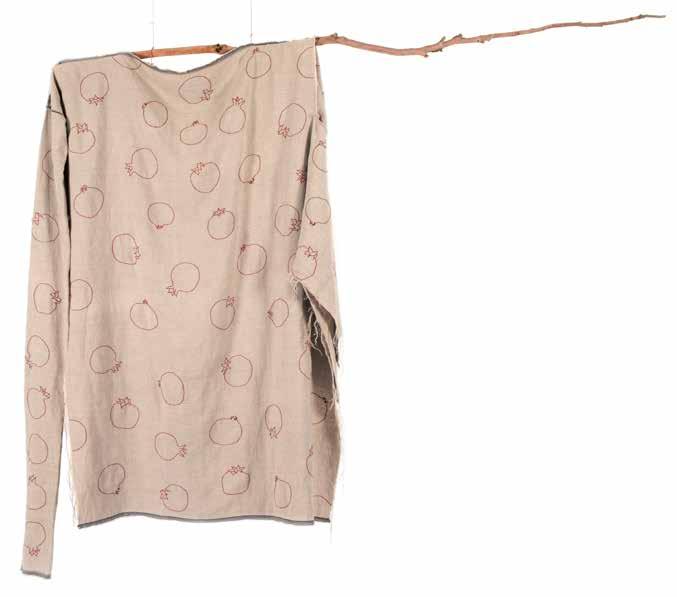
I first tasted pomegranate mixed into a cup of sour yoghurt while sitting on a stool in my grandfather’s kitchen. When the tree I planted shed its leaves in autumn and stood bare all winter, I thought it had died. And then, spring. Pomegranate, fruit from his Armenian homeland.
My grandfather’s father is buried in the old Armenian church in Kolkata. The church sits within the Barabazar, a bustling three hundred year-old market that is its own suburb. Inside the church walls, the graves lie flat to the ground and fill the entire courtyard, a marble carpet to be traversed. The names above, bones below.
Glistening jewels and spent white bones held in earthy darkness. Beginnings and a deep resting place.
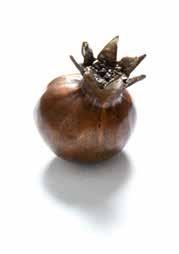
what
is held, is here
What is always striking on encountering Michele Elliot’s artwork is its rich layering of material and meaning. Elliot’s objects and installations integrate vast, incommensurate phenomena with intimate, embodied experience, playing with proximity and distance, balanced on the cusp between aesthetic resolution and ongoing possibilities. Together with a deep understanding of the resonance of found fragments, that love of continuous process where the acts of making and conceptual exploration are fully embedded in the artist’s life is evident in all her pieces. Elliot’s choice of materials, including hair, cloth and wood, and artistic processes such as stitching and assemblage, all centre interconnectedness and relationship, as do her thematic and personal concerns. In every sense, then, Elliot’s artmaking is grounded in an ethics of care. Guided by how the materials they are crafted from relate to each other and to the lifeworld, her works embody attentiveness, responsiveness, and a deep commitment to alleviate harm, or as foundational care theorists Berenice Fisher and Joan Tronto put it, to ‘maintain, continue, and repair our world so that we may live in it as well as possible’.
Elliot’s work gives us pause to acknowledge our fundamental imbrication in networks of relations. These hold us, here, in our daily lives, but they also provide us with at times surprising opportunities for change. When Elliot patiently gathers fallen leaves and bark from those trees in her garden scathed by fire and drought, distils their pigments to dye cloths handed down through generations, then mindfully sews garments destined to drift in the gallery space, those relations are materialized, but not concretised (cloak (black summer smoke bath / lost orchard silk/thakurma churi), 2023 and cloak (das hajar tender stranger) 2024). When she crafts architectural supports out of laboriously pleated and stitched soft sheets dyed with onion skins, she reminds us that tiny gestures, made by hand, are at the core of the sturdiest of structures (soft column (gold), (blue) and (spare), 2024). And when she singles out the found branch of a pomegranate tree by wrapping and suspending it in linen thread, she foregrounds the underlying resilience and integrity that sustains the more than human world (variants and the garden (branch, promise, shift), 2022-24). Such reflections on broader themes are all mediated through the artist’s personal experience, including references to her Anglo-
Indian and Armenian family history, and to traumatic historical events she has directly witnessed such as the Nepal earthquake of 2015 when ten thousand people lost their lives.
Having explored and finessed a large repertoire of media and techniques, Elliot has consistently returned to textiles and stitching for their capacity to bring things together physically and metaphorically through means that are at hand — humble, accessible, and low-tech. Her works offer many threads to unravel, points of connection that are enhanced by the artist’s long-standing engagement with community. Elliot’s original artist residency with Tender Funerals — a not-for-profit community funeral service in her local area founded on principles of kindness and holistic care — entailed designing a creative workshop to facilitate the sharing and processing of grief. This took the form of a fortnightly sewing circle where grieving folk could make embroideries, or other ‘tender cloths’ including shrouds, in memory of their loved ones, often through repurposing meaningful textiles. Cloth in its many forms has a strong sensual register: we wear it close to the skin, it covers, protects, and even comforts our bodies at each stage of life. Imbued with identity and indeed with our intimate smells, the clothes that outlive us become poignant memorials of who we were, while the family linen brings to our daily rituals the palpable presence of those who came before.
‘what is held, is here’ draws on the affective tenor of these workshops’ intense exchanges, where delicate manual labour and aesthetics intersect to begin to ‘transform raw grief into tranquil sadness’, to cite philosopher Arthur Danto’s description of the power of beauty. Such grief may stem from loss through death or illness — an experience the artist herself has recently suffered — but extends to climate grief and the melancholia that time’s passing often invokes, particularly in a neoliberal culture which values individual, timebound achievement above all else. Elliot has brought the distinctive qualities of her creative approach — empathic listening, understanding of the sensorial power of cloth, and commitment to the aesthetics of beauty — to various other community settings such as palliative care, which have in turn deepened her practice.
While Elliot’s stitching necessarily mobilises discourses around the impact on art historical narratives of revalorizing
(above) variants and the garden: shift 2022-24, gifted linen, cotton thread, blackbutt wood (Euc. Pilularis); 152 x 210 cm (right) promise 2024, bronze; 6 x 15.5 (dia) cm (ed. 5)gendered domestic craft traditions, its framing of abstraction through sewing is particularly compelling, as in the series the confidantes (2018-2024). Several years after her father’s death, the 23 handkerchiefs left among his personal effects eventually found their way into the artist’s integrative practice. Elliot combined the handkerchiefs with other scraps of once functional cloth, stitched over their existing patterns, then photographed them on a light box to reveal the material’s original woven substrate, carrying all the discolorations and distensions wrought by use and time. The resulting prints hover between geometric abstraction, decorative textiles, and bodily abjection, a confluence of references that elegantly captures the existential complexities of grieving. Elliot further extended the resonance of this series by inviting 22 women within her social circle to reflect on their late fathers and write a short text. Once she had received all the writing, she paired each text with an image, thus merging social practice and formal experimentation through a deeply personal lens. The images’ individual titles, which the artist excerpted from the daughters’ reflections, give us a glimpse into the diversity of the experience of loss: relentless work and whiteness, a world of silence, nothing to mourn.
The titles, and short reflections, also highlight another aspect of Elliot’s practice: a love of words and writing, including for their power as memory keepers. ‘what is held, is here’ shares its title with an essay Elliot wrote in 2018 based on her thirty-year correspondence with the artist Jo Darbyshire; it was her contribution to a catalogue that aimed, through conversation and contemplation, to remember the under-recognised history of Western Australian feminist art practice and to question how official ‘histories’ are made. This subtle reference is yet another instance of Elliot’s centring of relationship and interconnectedness, an acknowledgement of the circles of care that make her work possible.
‘what is held, is here’ is gentle and powerful. The artworks, beautifully crafted over time in relationship with repurposed materials and community, are a generous invitation to reflect on our own circles of care, not only in times of loss but in our everyday interactions with the world.
Jacqueline Millner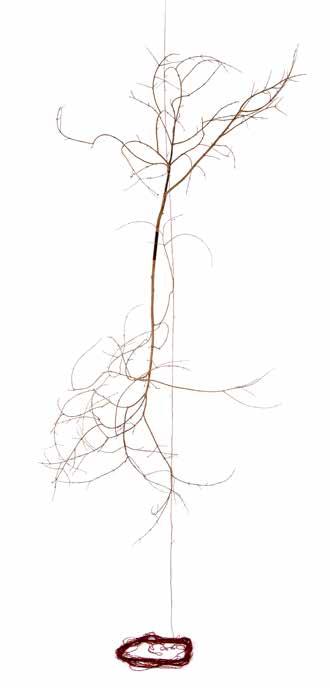
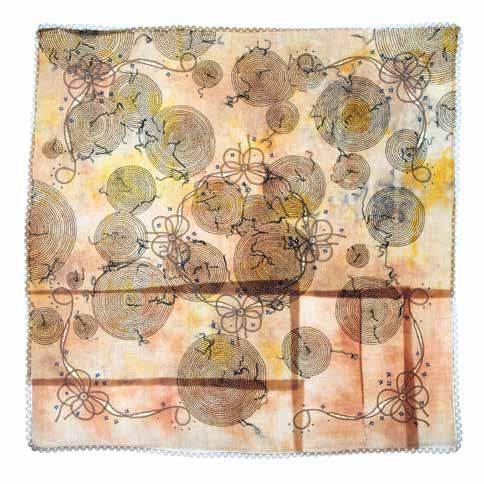
mother: This cloth belonged to my mother. Its place was on her small dining table, with one side folded down and three chairs around it. The table sat up against a window, looking out on her geraniums and beyond, the bay. In the distance, cranes worked the port, planes landing, planes taking off. Containers, vessels, bodies in space. Time and time over.
brother: now, I stitch in vigil. Time is of, is the essence. Creeps along and speeds past. I sit within its passage. The stitching is a counting, though I seem have lost track. The circling forms a holding pattern before dropping down to land. Suspended, high up over Kamay and her blue waters.





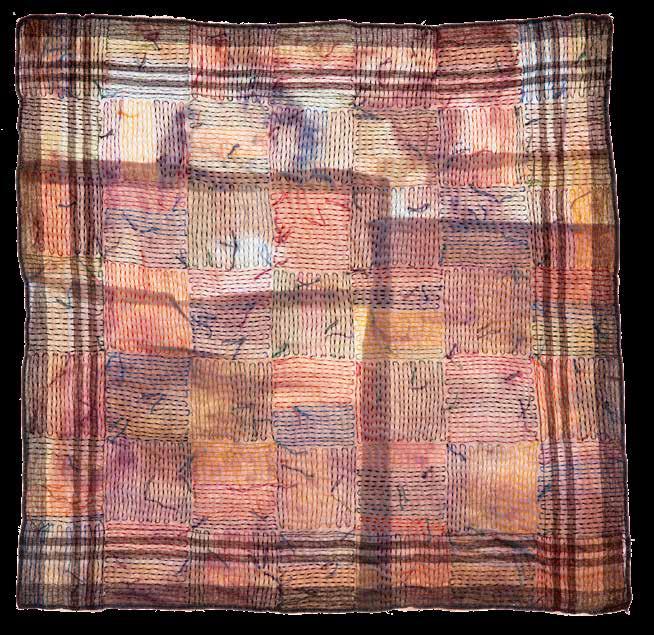 the confidantes (hold you close); (to swim); (the typewriter); (nothing to mourn), 2018-24 (clockwise from top left)
the confidantes (hold you close); (to swim); (the typewriter); (nothing to mourn), 2018-24 (clockwise from top left)


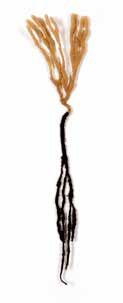
this and that what is certain is this this rush to the end time accelerates and slows all at once as if it is possible to count, to feel every second
a philosopher once wrote that being is round circle cycle same the stitches form ever expanding circles in blue and white a drop in the (distant) ocean they are the counting they count each stitch counts each breath counts until the last the circle complete it must add up to something
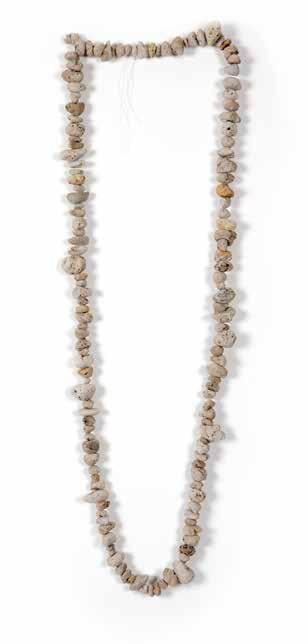


The artist would like to thank:
Chris Mills, Claire Freer, David Roach, Dominic Lefebvre, Frances Mocnik, Helena Fox, Jacqueline Millner, Jan Idle, Joanne Linsdell, Julie Ryder, Lizzie Muller, Mary Fitzpatrick, Melinda Young, Michael Strachan, Photomart (Brent, Josh and Keziah), Redmond Bridgeman, Samorn Sanixay, Shaima Hejab, Shingie Ruzengwe, Tender Funerals Illawarra
All photography: Frances Mocnik (otherwise noted)
Printing/framing: Photomart
I live and work on Dharawal Country, on the unceded lands of the Wodi Wodi people.
My deep respect to their Elders, their people and to this Country.
weights and measures: an inventory of sheets
1. cotton, white, 500 grams
143 x 220 cm
(hem top 5.4 cm bottom 4.8 cm)
condition thin, no label
2. cotton, white, 870 grams
232 x 169 cm|
(hem top 8 cm bottom 2 cm)
condition, good, label ACTIL 2006, made in Australia, SWAZZ in black marker bottom left corner
gifted
pleated 12/22; alum and calc carb mordant 12/22; dyed 1/23 red and yellow onion skin bath; unpicked 3/1
3. cotton, white, 620 grams
244 x 155.5 cm
(hem top 9.5 cm bottom 3.6 cm) condition, as new, unused, in cellophane packet. Label NILE, made in Australia
mother’s linen cupboard pleated 12/22; alum and calc carb mordant 12/22, dyed 3/23 red and yellow onion skin bath, unpicked 1/23
4. cotton, white, 710 grams
244 x 179 cm
(hem top 3 cm bottom 4.3 cm)
condition as new. Stamped in faded purple ink ‘Finlay’s 100% pure cotton pleated 1/23; alum and calc carb mordant, dyed 2/24 red and onion skin
5. cotton, white, 640 grams
244.5 x 156.5 cm
(hem top 9.6 cm bottom 3.2 cm)
Pleated 21/2/23;
6. cotton, white, 740 grams
244.5 x 177 cm
(hem top 8 cm bottom 4.5 cm)
As new, hot washed. Label An ACTIL Product
7. cotton, white, Pleated 11/23; alum and calc carb mordant, dyed 2/24 red and onion skin
8. cotton, white, 806 grams
228 x 150 cm
No label
Small grey stain along edge, tiny dark brown spot
Cyanotype printing Feb - Mar 24
9. linen, white, 1580 grams to measure
floral garden mourning ritual gifted Stephanie Jones
10. cotton, white, 1010 grams 244 x 180 cm
Printed Dec 22/Jan 23; Dec 23/Jan 24
New Year’s Day slip
11. cotton flannelette, multistripe, 420 grams 156 x 230 cm (hem top bottom) used and even condition no label gifted
12. cotton, green floral Chintz style print, 600 grams
148 x 238 cm (hem top bottom) good condition, as new. Label WASHING INSTRUCTIONS
HOT MACHINE WASH
SPIN DRY HOT IRON
Pleated Nov 23; indigo dyed Feb 24
Unpicked Feb 24
13. cotton, white, 710 grams
156 X 216 cm unpick and measure hem top bottom good condition; frayed L shaped hole at middle edge 5.5 x 4.5 cm; two small tear on selvedge, same side approx. (to mend)
Label ACTIL PRODUCT COTTON
14. cotton flannelette, dark pink floral print
15. cotton, white weigh and measure mend top hem (pulled thread work)
16. cotton, yellow orange brown floral print,
17. cotton, white Bradmill
18. cotton, white Bradmill 2
19. cotton, white, 580 grams 218 x 247 cm (hem top 3.5cm bottom 3 cm)
3 tiny brown spots near top hem; small dark grey marks near bottom hem, possibly old ink stains cyanotype printing spares Mar 24
20. cotton, purple mauve blue yellow floral daisy print, 520 grams
210 x 288 cm
cut down centre, edges (thin) joined
21. cotton, blue flower print on white, 610 grams 172 x 244 cm
Pleated 11/23; 2/24: indigo vat
22. cotton, blue spots with gold flowers, 470 grams measure
pleated Jan 23; indigo dyed Feb 24 unpicked Mar 24
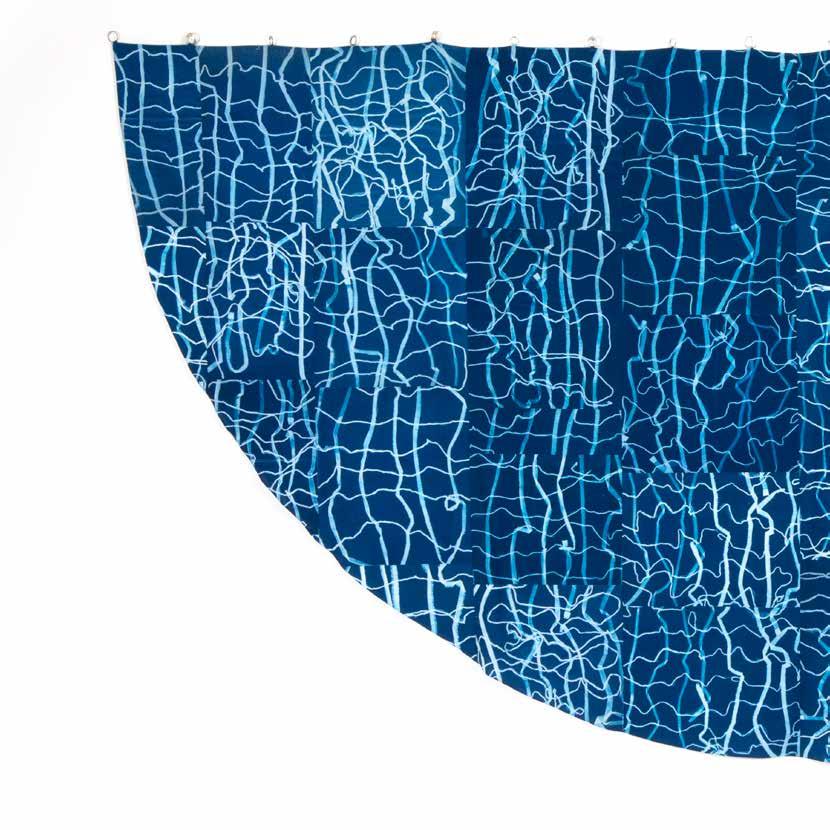
This project has been assisted by the Australian Government through Creative Australia, its arts funding and advisory body.
open Tues-Fri 10am-5pm, weekends 12-4pm
corner Kembla & Burelli streets Wollongong phone 02 4227 8500
www.wollongongartgallery.com www.facebook/wollongongartgallery
Image: cloak (das hajar tender stranger), 2024, cyanotype on cotton sheet, collected silver rings; 150 x 300 cm Wollongong Art Gallery is a service of Wollongong City Council, and is a member of Regional and Public Galleries of NSW. 5006410